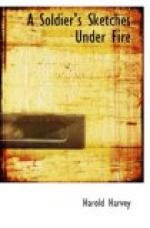The view of the site of the Sergeants’ Mess at Floriana gives a good idea of the massive style of architecture and the palatial design of many of the buildings. The big construction of the walls will be noted, and the height of the chimney. All the houses have flat roofs, and on them people sleep at night because of the intense heat. From the roof of this house is obtained the best view of the island. Although Malta is composed entirely of rock, flowers grow profusely, and a variety of creeper, very similar to our own azalea, climbs up the front of the forts, requiring little or no root. A garden of this flower was attached to the Sergeants’ Mess house.
FORTIFICATIONS.
[Illustration: Ordnance department, Malta.]
The ancient fortifications proved impregnable for ages, and are now modernised for the use of up-to-date artillery equipment. I show the exterior of the Army Ordnance Department, Fort Tigne, and on the extreme left, on the other side of the harbour, a portion of Fort Manoel.
THE MALTESE.
The habits and manners of the Maltese have long been notorious for their rude characteristics, probably attributable to the people’s Moorish origin, although the race has now blended with the smooth Italian. Throughout the Levant they have the bad name first deserved by their robberies and murders. British rule has effected great reforms, but it cannot change the leopard’s spots.
The experience of our boys in some of the outlying parts of the island, and even in many streets and cafes, was that these primitive people had not altogether lost their primitive instincts in the course of becoming civilised. One of their customary tricks is to offer one of their bangles, or some other souvenir, to get you to spend money in the cafes and dancing saloons, and he would be a clever man who ever succeeded in obtaining one of the souvenirs promised him from day to day. The women of Malta certainly have strong claims to beauty, at any rate up to the age of sixteen, for they mature early. They have large and lustrous black eyes, and are of a swarthy and somewhat Spanish type. They still wear the traditional hood, a black scarf, called a “Faldetta,” thrown over the head and shoulders, and disposed in such a style as to exhibit the countenance of the wearer in the most alluring form. Although picturesque in the distance, they are very slovenly in their hair and dress on closer acquaintance, and generally exhibit the traces of their Oriental origin. They are great experts in the making of Maltese lace, for which they have won a world-wide reputation, and their native filigree work is also very famous and very beautiful. Churches (where weddings are celebrated in the evening) are very numerous, and priests and friars are always to be seen in the streets. The boys of our regiment said that Malta was chiefly notable for “yells, smells, and bells.”




